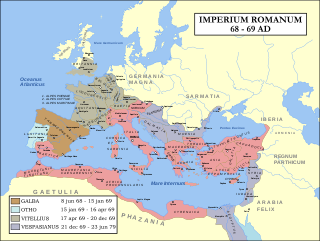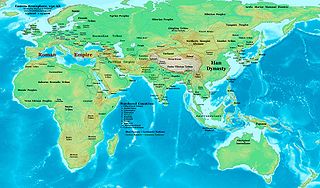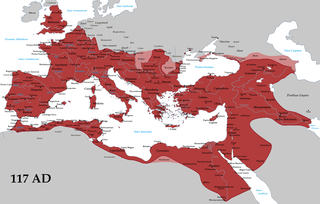
AD 69 (LXIX) was a common year starting on Sunday of the Julian calendar. In the Roman Empire, it was known as the Year of the consulship of Galba and Vinius. The denomination AD 69 for this year has been used since the early medieval period, when the Anno Domini calendar era became the prevalent method in Europe for naming years.

The 10s decade ran from January 1, AD 10, to December 31, AD 19.

The 30s decade ran from January 1, AD 30, to December 31, AD 39.

The 50s decade ran from January 1, 50, to December 31, 59. It was the sixth decade in the Anno Domini/Common Era, if the nine-year period from 1 AD to 9 AD is considered as a "decade".

The 60s decade ran from January 1, AD 60, to December 31, AD 69.

The 70s was a decade that ran from January 1, AD 70, to December 31, AD 79.

The 90s was a decade that ran from January 1, AD 90, to December 31, AD 99.

The 110s was a decade that ran from January 1, AD 110, to December 31, AD 119.
AD 65 (LXV) was a common year starting on Tuesday of the Julian calendar. At the time, it was known as the Year of the Consulship of Nerva and Vestinus. The denomination AD 65 for this year has been used since the early medieval period, when the Anno Domini calendar era became the prevalent method in Europe for naming years.
AD 67 (LXVII) was a common year starting on Thursday of the Julian calendar. At the time it was known as the Year of the Consulship of Julius Rufus and Fonteius Capito. The denomination AD 67 for this year has been used since the early medieval period, when the Anno Domini calendar era became the prevalent method in Europe for naming years.
The 190s decade ran from January 1, 190, to December 31, 199.

This article concerns the period 59 BC – 50 BC.
This article concerns the period 19 BC – 10 BC.

The gens Claudia, sometimes written Clodia, was one of the most prominent patrician houses at ancient Rome. The gens traced its origin to the earliest days of the Roman Republic. The first of the Claudii to obtain the consulship was Appius Claudius Sabinus Regillensis, in 495 BC, and from that time its members frequently held the highest offices of the state, both under the Republic and in imperial times.

The gens Julia was one of the most prominent patrician families in ancient Rome. Members of the gens attained the highest dignities of the state in the earliest times of the Republic. The first of the family to obtain the consulship was Gaius Julius Iulus in 489 BC. The gens is perhaps best known, however, for Gaius Julius Caesar, the dictator and grand uncle of the emperor Augustus, through whom the name was passed to the so-called Julio-Claudian dynasty of the first century AD. The nomen Julius became very common in imperial times, as the descendants of persons enrolled as citizens under the early emperors began to make their mark in history.

Legio III Gallica was a legion of the Imperial Roman army. The cognomen Gallica suggests that its earliest recruits came from veterans of the Gallic legions of Gaius Julius Caesar, a supposition supported by its emblem, a bull, a symbol associated with Caesar. The legion was based for most of its existence at Raphanea, Roman Syria, and was still active in Egypt in the early 4th century.
Gaius Nymphidius Sabinus was a Prefect of the Praetorian Guard during the rule of Emperor Nero from AD 65 until his death in 68. He shared this office together with Ofonius Tigellinus, replacing his previous colleague Faenius Rufus. During the second half of the 60s, Nero grew increasingly unpopular with the people and the army, leading to a number of rebellions which ultimately caused his downfall and suicide in 68. Nymphidius took part in the final conspiracy against Nero and persuaded the Praetorian Guard to desert him, but when he attempted to have himself declared emperor, he was killed by his own soldiers.
Gaius Caesonius Macer Rufinianus was a Roman military officer and senator who was appointed suffect consul in around AD 197 or 198. He was the first member of gens Caesonia to hold a consulship.

Lucius Caesennius Sospes was a Roman senator of the 1st and 2nd centuries AD. Through his mother, Flavia Sabina, a cousin of the Roman emperors Titus and Domitian, his connections enabled him to hold a series of civil and military imperial appointments. He was suffect consul in the nundinium of May to August 114 as the colleague of Gaius Clodius Nummus. Sopses is known primarily from an inscription found in Pisidian Antioch.












